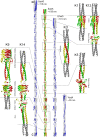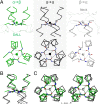Complete fiber structures of complex trimeric autotransporter adhesins conserved in enterobacteria
- PMID: 23213248
- PMCID: PMC3529040
- DOI: 10.1073/pnas.1211872110
Complete fiber structures of complex trimeric autotransporter adhesins conserved in enterobacteria
Abstract
Trimeric autotransporter adhesins (TAAs) are modular, highly repetitive surface proteins that mediate adhesion to host cells in a broad range of Gram-negative pathogens. Although their sizes may differ by more than one order of magnitude, they all follow the same basic head-stalk-anchor architecture, where the head mediates adhesion and autoagglutination, the stalk projects the head from the bacterial surface, and the anchor provides the export function and attaches the adhesin to the bacterial outer membrane after export is complete. In complex adhesins, head and stalk domains may alternate several times before the anchor is reached. Despite extensive sequence divergence, the structures of TAA domains are highly constrained, due to the tight interleaving of their constituent polypeptide chains. We have therefore taken a "domain dictionary" approach to characterize representatives for each domain type by X-ray crystallography and use these structures to reconstruct complete TAA fibers. With SadA from Salmonella enterica, EhaG from enteropathogenic Escherichia coli (EHEC), and UpaG from uropathogenic E. coli (UPEC), we present three representative structures of a complex adhesin that occur in a conserved genomic context in Enterobacteria and is essential in the infection process of uropathogenic E. coli. Our work proves the applicability of the dictionary approach to understanding the structure of a class of proteins that are otherwise poorly tractable by high-resolution methods and provides a basis for the rapid and detailed annotation of newly identified TAAs.
Conflict of interest statement
The authors declare no conflict of interest.
Figures







Similar articles
-
Molecular characterization of the EhaG and UpaG trimeric autotransporter proteins from pathogenic Escherichia coli.Appl Environ Microbiol. 2012 Apr;78(7):2179-89. doi: 10.1128/AEM.06680-11. Epub 2012 Jan 27. Appl Environ Microbiol. 2012. PMID: 22286983 Free PMC article.
-
A domain dictionary of trimeric autotransporter adhesins.Int J Med Microbiol. 2015 Feb;305(2):265-75. doi: 10.1016/j.ijmm.2014.12.010. Epub 2014 Dec 24. Int J Med Microbiol. 2015. PMID: 25583454 Review.
-
Structural Basis for Toughness and Flexibility in the C-terminal Passenger Domain of an Acinetobacter Trimeric Autotransporter Adhesin.J Biol Chem. 2016 Feb 19;291(8):3705-24. doi: 10.1074/jbc.M115.701698. Epub 2015 Dec 23. J Biol Chem. 2016. PMID: 26698633 Free PMC article.
-
UpaG, a new member of the trimeric autotransporter family of adhesins in uropathogenic Escherichia coli.J Bacteriol. 2008 Jun;190(12):4147-61. doi: 10.1128/JB.00122-08. Epub 2008 Apr 18. J Bacteriol. 2008. PMID: 18424525 Free PMC article.
-
Structure and biology of trimeric autotransporter adhesins.Adv Exp Med Biol. 2011;715:143-58. doi: 10.1007/978-94-007-0940-9_9. Adv Exp Med Biol. 2011. PMID: 21557062 Review.
Cited by
-
Virulence-linked adhesin drives mutualist colonization of the bee gut via biofilm formation.bioRxiv [Preprint]. 2024 Oct 14:2024.10.14.618124. doi: 10.1101/2024.10.14.618124. bioRxiv. 2024. PMID: 39464101 Free PMC article. Preprint.
-
Sequential Translocation of Polypeptides across the Bacterial Outer Membrane through the Trimeric Autotransporter Pathway.mBio. 2019 Oct 22;10(5):e01973-19. doi: 10.1128/mBio.01973-19. mBio. 2019. PMID: 31641085 Free PMC article.
-
Interactions between the Trimeric Autotransporter Adhesin EmaA and Collagen Revealed by Three-Dimensional Electron Tomography.J Bacteriol. 2019 Jul 24;201(16):e00297-19. doi: 10.1128/JB.00297-19. Print 2019 Aug 15. J Bacteriol. 2019. PMID: 31160398 Free PMC article.
-
Potential for Improving Potency and Specificity of Reovirus Oncolysis with Next-Generation Reovirus Variants.Viruses. 2015 Dec 1;7(12):6251-78. doi: 10.3390/v7122936. Viruses. 2015. PMID: 26633466 Free PMC article. Review.
-
The C-terminal head domain of Burkholderia pseudomallei BpaC has a striking hydrophilic core with an extensive solvent network.Mol Microbiol. 2022 Jul;118(1-2):77-91. doi: 10.1111/mmi.14953. Epub 2022 Jul 1. Mol Microbiol. 2022. PMID: 35703459 Free PMC article.
References
-
- Gerlach RG, Hensel M. Protein secretion systems and adhesins: The molecular armory of Gram-negative pathogens. Int J Med Microbiol. 2007;297(6):401–415. - PubMed
-
- Linke D, Riess T, Autenrieth IB, Lupas A, Kempf VA. Trimeric autotransporter adhesins: Variable structure, common function. Trends Microbiol. 2006;14(6):264–270. - PubMed
Publication types
MeSH terms
Substances
Associated data
- Actions
- Actions
- Actions
- Actions
- Actions
- Actions
LinkOut - more resources
Full Text Sources
Other Literature Sources
Molecular Biology Databases

